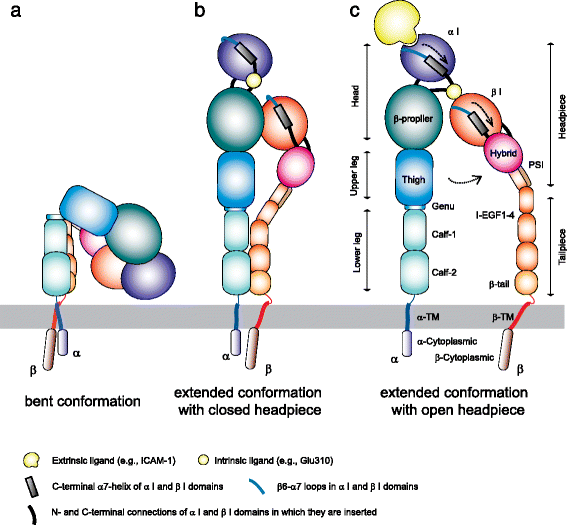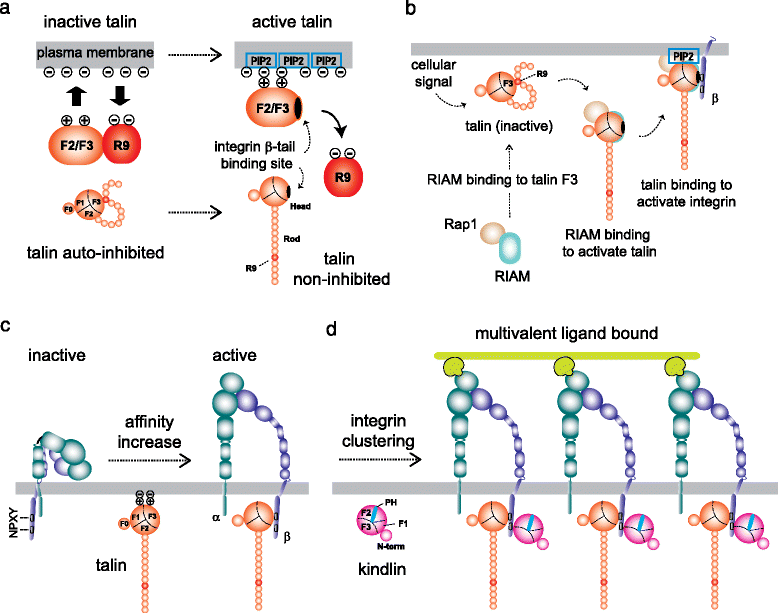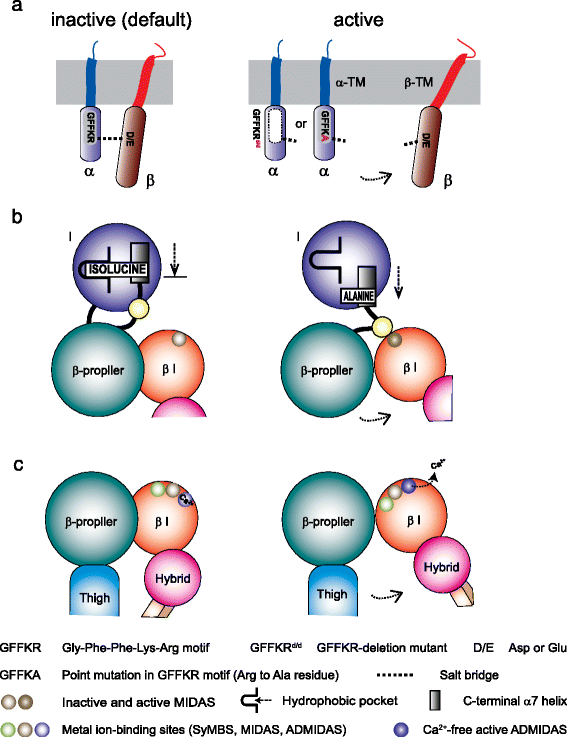Structural basis of blocking integrin activation and deactivation for anti-inflammation
- PMID: 26152212
- PMCID: PMC4495637
- DOI: 10.1186/s12929-015-0159-6
Structural basis of blocking integrin activation and deactivation for anti-inflammation
Abstract
Integrins mediate leukocyte accumulation to the sites of inflammation, thereby enhancing their potential as an important therapeutic target for inflammatory disorders. Integrin activation triggered by inflammatory mediators or signaling pathway is a key step to initiate leukocyte migration to inflamed tissues; however, an appropriately regulated integrin deactivation is indispensable for maintaining productive leukocyte migration. While typical integrin antagonists that block integrin activation target the initiation of leukocyte migration, a novel class of experimental compounds has been designed to block integrin deactivation, thereby perturbing the progression of cell migration. Current review discusses the mechanisms by which integrin is activated and subsequently deactivated by focusing on its structure-function relationship.
Figures



Similar articles
-
Right on the spot. Chemokine triggering of integrin-mediated arrest of rolling leukocytes.Thromb Haemost. 2006 Jan;95(1):5-11. Thromb Haemost. 2006. PMID: 16543955 Review.
-
β2 integrin activation and signal transduction in leukocyte recruitment.Am J Physiol Cell Physiol. 2021 Aug 1;321(2):C308-C316. doi: 10.1152/ajpcell.00560.2020. Epub 2021 Jun 16. Am J Physiol Cell Physiol. 2021. PMID: 34133240 Free PMC article. Review.
-
β2 Integrin CD11d/CD18: From Expression to an Emerging Role in Staged Leukocyte Migration.Front Immunol. 2021 Nov 8;12:775447. doi: 10.3389/fimmu.2021.775447. eCollection 2021. Front Immunol. 2021. PMID: 34858434 Free PMC article. Review.
-
Integrin α10β1: a collagen receptor critical in skeletal development.Adv Exp Med Biol. 2014;819:61-71. doi: 10.1007/978-94-017-9153-3_4. Adv Exp Med Biol. 2014. PMID: 25023167 Review.
-
Integrin αDβ2 (CD11d/CD18) is expressed by human circulating and tissue myeloid leukocytes and mediates inflammatory signaling.PLoS One. 2014 Nov 21;9(11):e112770. doi: 10.1371/journal.pone.0112770. eCollection 2014. PLoS One. 2014. PMID: 25415295 Free PMC article.
Cited by
-
Role of β1 integrin in thrombocytopoiesis.Fac Rev. 2021 Sep 1;10:68. doi: 10.12703/r/10-68. eCollection 2021. Fac Rev. 2021. PMID: 34557872 Free PMC article. Review.
-
Regenerative Medicine Therapies for Targeting Neuroinflammation After Stroke.Front Neurol. 2018 Sep 3;9:734. doi: 10.3389/fneur.2018.00734. eCollection 2018. Front Neurol. 2018. PMID: 30233484 Free PMC article. Review.
-
Nanotechnology's frontier in combatting infectious and inflammatory diseases: prevention and treatment.Signal Transduct Target Ther. 2024 Feb 21;9(1):34. doi: 10.1038/s41392-024-01745-z. Signal Transduct Target Ther. 2024. PMID: 38378653 Free PMC article. Review.
-
The Phosphorylation and Distribution of Cortactin Downstream of Integrin α9β1 Affects Cancer Cell Behaviour.Sci Rep. 2016 Jun 24;6:28529. doi: 10.1038/srep28529. Sci Rep. 2016. PMID: 27339664 Free PMC article.
-
The Spike Glycoprotein of SARS-CoV-2 Binds to β1 Integrins Expressed on the Surface of Lung Epithelial Cells.Viruses. 2021 Apr 9;13(4):645. doi: 10.3390/v13040645. Viruses. 2021. PMID: 33918599 Free PMC article.
References
Publication types
MeSH terms
Substances
LinkOut - more resources
Full Text Sources
Other Literature Sources

